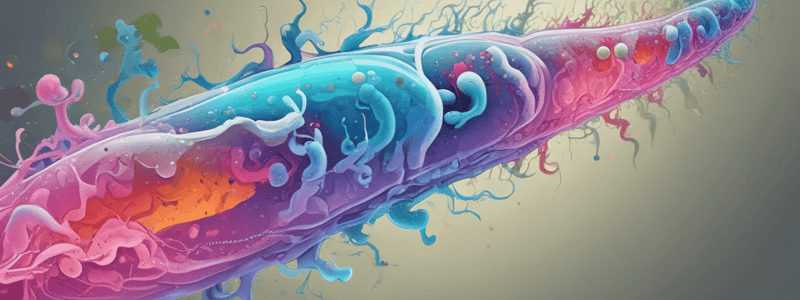Podcast
Questions and Answers
Which essential element is sequestered by siderophores synthesized by many bacteria?
Which essential element is sequestered by siderophores synthesized by many bacteria?
- Potassium
- Carbon
- Iron (correct)
- Chloride
Halophiles require salt levels of:
Halophiles require salt levels of:
- 0.5M to 1.5M
- 2.8M to 6.2M (correct)
- 1.5M to 2.6M
- 6.2M to 10M
What happens to obligate acidophiles when placed in neutral pH?
What happens to obligate acidophiles when placed in neutral pH?
- They thrive and reproduce rapidly.
- They remain dormant.
- Cytoplasmic membrane dissolves, and cells lyse. (correct)
- They grow optimally.
Which type of bacteria grow well at 0°C with an optimum of 15°C or lower?
Which type of bacteria grow well at 0°C with an optimum of 15°C or lower?
What is the main characteristic of extreme halophiles?
What is the main characteristic of extreme halophiles?
Neutrophiles thrive in which pH range?
Neutrophiles thrive in which pH range?
Why is water essential for bacterial growth?
Why is water essential for bacterial growth?
What is a characteristic of psychrophiles?
What is a characteristic of psychrophiles?
Which type of bacteria can grow optimally between 20-30ºC?
Which type of bacteria can grow optimally between 20-30ºC?
What kind of bacteria are most associated with human infections?
What kind of bacteria are most associated with human infections?
Where are thermophiles typically found?
Where are thermophiles typically found?
What kind of bacteria can grow at temperatures of 90ºC or higher?
What kind of bacteria can grow at temperatures of 90ºC or higher?
Which bacteria are capable of growth in full atmospheric oxygen tension?
Which bacteria are capable of growth in full atmospheric oxygen tension?
Which of the following bacteria cannot use oxygen as a terminal electron receptor?
Which of the following bacteria cannot use oxygen as a terminal electron receptor?
Which bacteria can tolerate and grow in the presence of oxygen but do not use it?
Which bacteria can tolerate and grow in the presence of oxygen but do not use it?
Which enzymes are used by bacteria to protect themselves from toxic oxygen products?
Which enzymes are used by bacteria to protect themselves from toxic oxygen products?
Flashcards are hidden until you start studying
Study Notes
Temperature
- Psychrotrophs can grow at 0°C and have an optimum temperature of 20-30°C, found in soil, water, milk, and dairy products, e.g. Listeria monocytogenes.
- Mesophiles are most bacteria associated with human infection, growing optimally between 9 and 40°C.
- Thermophiles grow at 55°C or higher, found in compost, hay stacks, hot water lines, and hot springs, with more heat-stable enzymes and protein synthesis systems.
- Hyperthermophiles can grow at 90°C or 100°C, found in hot areas of the sea floor.
Bacteria and Oxygen
- Aerobes are capable of growth in full oxygen tension (21% in the atmosphere), using oxygen as a terminal receptor for electron transport chain in aerobic respiration.
- Anaerobic organisms lack a respiratory system that can use oxygen, with obligate anaerobes being killed by oxygen, and facultative anaerobes able to decompose toxic oxygen products.
- Microaerophiles are anaerobes that can tolerate oxygen and grow in its presence, but do not use it.
- Strict anaerobes are killed by oxygen but can be found in otherwise aerobic environments, e.g. the mouth.
Bacterial Culture Media
- Understanding growth requirements helps in designing culture media for a given genera and enables selectivity.
- Knowledge of metabolic pathways helps in designing identification systems/media.
Environmental Factors Affecting Bacterial Growth
- Source of nitrogen, carbon, essential ions, and nutrients.
- Temperature.
- Water, salt levels.
- pH.
- Atmosphere (O2 levels).
Essential Elements
- Carbon, oxygen, nitrogen, hydrogen, sulphur, phosphorous, potassium, magnesium, calcium, iron, sodium, and chloride.
- Bacteria can synthesise molecules called siderophores to sequester iron from host iron stores.
Salt (Osmolarity)
- Halophiles have adapted to higher salt levels (seawater has 3% salt), requiring salt levels of 2.8M to saturation of 6.2M.
- Halophiles modify structure of proteins and membranes, and extreme halophiles accumulate levels of potassium to remain hypertonic (4–7M).
- Halotolerant bacteria can tolerate some reduction in salt levels.
Water
- 80% or more of the cell mass is water, which is essential for growth.
- Free available water (A) is necessary for nutrients and waste products to enter and leave the cell.
Effect of pH
- Most environments have a pH of between 5 and 8-9, and most organisms grow within these parameters.
- Acidophiles grow optimally between pH 0 and 5.5.
- Neutrophiles grow between pH 5.5 and 8.
- Alkalophiles grow between pH 8.5-11, with extreme alkalophiles at pH 10 or above.
- Most bacteria and protozoa are neutrophiles, while fungi require slightly acid conditions (pH 4-6), and algae favour acidity.
Studying That Suits You
Use AI to generate personalized quizzes and flashcards to suit your learning preferences.




